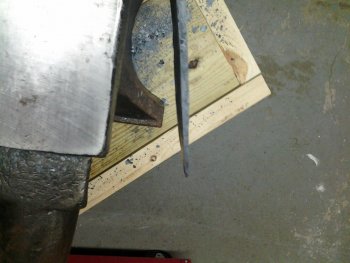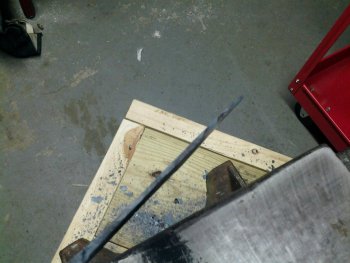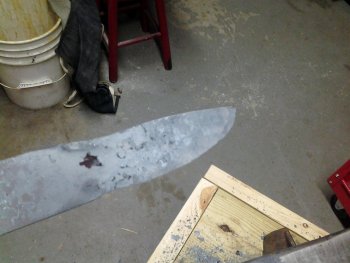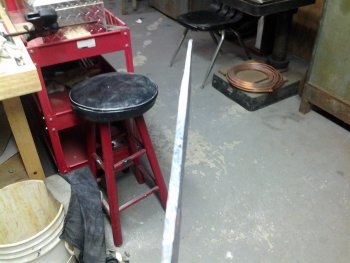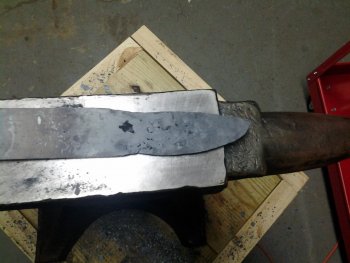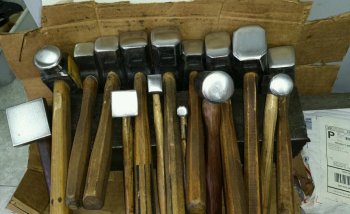You are using an out of date browser. It may not display this or other websites correctly.
You should upgrade or use an alternative browser.
You should upgrade or use an alternative browser.
First shot at forging a blade
- Thread starter Freds Edge
- Start date
Doug Lester
Well-Known Member
It looks like you are not bringing the face of the hammer down parallel to the face of the anvil. Check the height. You should be able to stand straight beside the anvil and have you knuckles just brush the top. Also make sure that there are no sharp lines of transition in the face of the hammer and I also have more luck with a flatter face on the hammer than a more crowned one. Other than that it's learning hammer control and not trying to bang the heck out of the steel. I can't tell from the pictures if the roughness on the blade is just fire scale built up on the surface or if you've forged fire scale from the anvil into the surface of the blade. Wipe the fire scale off the anvil when you return the steel to the forge to reheat it.
Doug
Doug
EdCaffreyMS
"The Montana Bladesmith"
I agree with Doug...... it could also be the hammer face.... it should be a smooth dome shaped face, without the sharp edge that you generally see on commercially available hammers. Anvil height is probably one of the most critical factors that many don't think about, or realize.
3/16" thick stock isn't easy to forge.....it often wants to fold over when you try to make it more narrow. Personally, I recommend using 1/4'+ to learn, and then as your skills increase, you MIGHT go to thinner stock. Since you're coming at this with the mindset of a stock removal makers, there are a few things you have to consider when it comes to the differences between the two methods. One being the thickness of your base material. With stock removal, if you start with 3/16" thick stock, you're not going to have to remove much, if any from the sides of a blade, meaning that you will likely end up with near the same thickness you started with. Not so with forging. Personally, I grind the sides of a blade no less then 3 times throughout the process. Once after annealing to remove the forge scale (with an angle grinder), Once during rough grinding, and again after heat treat when I finish grind. That's assuming that the forging technique is good, and you don't put a lot of dings/dents into the sides of a blade. So with that in mind, 1/4" thick to start out is a good thing. Remember....you can always grind it off is necessary.....but you can never add more if you need it.
There's a lot to learn when it comes to forging, so don't get down on yourself. Its just going to take time to learn the new skills.... and after a couple hundred blades, the hammer learns what its suppose to do... thats when the muscle memory takes over.
3/16" thick stock isn't easy to forge.....it often wants to fold over when you try to make it more narrow. Personally, I recommend using 1/4'+ to learn, and then as your skills increase, you MIGHT go to thinner stock. Since you're coming at this with the mindset of a stock removal makers, there are a few things you have to consider when it comes to the differences between the two methods. One being the thickness of your base material. With stock removal, if you start with 3/16" thick stock, you're not going to have to remove much, if any from the sides of a blade, meaning that you will likely end up with near the same thickness you started with. Not so with forging. Personally, I grind the sides of a blade no less then 3 times throughout the process. Once after annealing to remove the forge scale (with an angle grinder), Once during rough grinding, and again after heat treat when I finish grind. That's assuming that the forging technique is good, and you don't put a lot of dings/dents into the sides of a blade. So with that in mind, 1/4" thick to start out is a good thing. Remember....you can always grind it off is necessary.....but you can never add more if you need it.
There's a lot to learn when it comes to forging, so don't get down on yourself. Its just going to take time to learn the new skills.... and after a couple hundred blades, the hammer learns what its suppose to do... thats when the muscle memory takes over.
Freds Edge
Well-Known Member
Thanks guy's for the input , I will check the height of my anvil and today I did order quite a bit of 1/4 1080 enough to keep me busy for sometime .As for my hammer it is just an old 2 1/2 lb penning hammer that was around , I will take a good look at it and if need be replace it .
TacticallySharp
KNIFE MAKER
Freds Edge
Well-Known Member
Al I can say George is WOWWW a new goal.

